 Be Inspired Blog - Arizona
Be Inspired Blog - Arizona
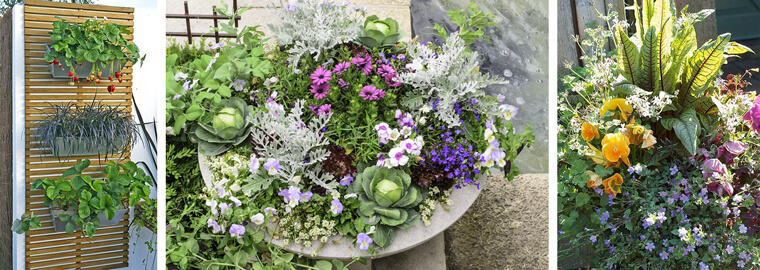
How to Include Edibles in Your Landscape Container Gardens
We previously wrote about a handful of popular edible flowers that are delicious in salads and desserts. Today, we are going to cover how to grow edible flowers in containers, different types of containers for your landscape and other delicious plants you can grow in your container garden.
How to Grow Edible Flowers in Containers
Edible flowers are fun and delicious, and can also be grown in a beautiful container in your garden. Here are some helpful tips from HGTV to grow your own:
- Prep the Bag: First, prepare the container by lining it with garbage bags. Then, use scissors to cut holes in the base for water drainage. It’s important to remember to make a hole through both the bag and the lining.
- Add Potting Soil: Combine potting soil with a slow-release fertilizer and use the mixture to fill the basket practically to the brim, ready to sow the seed; water the soil and let it drain through.
- Plant the Seeds: Make plenty of 1/2-inch-deep holes around the soil in the container and in the center. Make sure they are 4 inches (10 cm) apart, place a seed into each hole and cover with soil.
- Wait to Water: Before you water your seeds, wait for them to start growing a little. Green sprouts beginning to pop out of the dirt signal that it’s time to start giving them some water.
- Harvest and Eat: When enough leaves have appeared and the beautiful flowers bloom, they are ready to eat and enjoy. If you leave some flowers on the stalks, they will form tiny wrinkled seeds, which are edible too. Add a few tasty leaves and flowers to a mixed leaf salad, or you can make floral ice cubes by putting a few blooms into an ice cube tray with water and freezing it.
- Care for Your Plants: To adequately take care of your edible flowers they need to be in full sun and poor, dry soil. Depending on the variety you are growing, height will vary. Although these plants prefer the soil to be kept fairly dry, if you are using a hanging basket or bag the soil can dry out quickly, so water regularly – especially in our dry weather. If you leave the petals on the plant, collect the seeds when the flowers have died. They can be stored in an airtight container in a cool dry place; don’t forget to label them for next year’s crops.
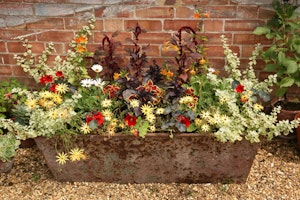 Landscape Container Gardening
Landscape Container Gardening
Gardening with larger containers can also be a fun addition to your yard.
No matter the size of your garden, if you properly and strategically use different sizes, heights, shapes and colors of containers you can create a spectacular look, whether they are grouped together or spaced throughout the area. Containers can also be manipulated by using bricks or other raisers to make them appear taller if you’d like.
Containers also offer the advantage of being able to move around if you want to change the way your garden looks or group them differently. As the University of Illinois suggests:
- Putting containers together as a grouping can also have its advantages especially when they are first planted. Newly planted containers often don't have that ‘full’ look right away. By grouping containers closer together, you can give the illusion of fullness. As the containers fill out, they can be spread further apart to present a totally different look. The same number of containers now takes up more square feet and looks like you actually added containers to the display.
The University of Illinois also suggesting using them in and around your garden. They explain:
- Large, bold containers worked into a flower or shrub border now becomes part of the planting bed. They are looked at as specimen or sculptural accents. The base of the pot is surrounded by annuals or perennials, the container is a piece of art, and it is topped off with a floral display. Landscaping with containers can be as simple as one well-chosen and planted pot to a group of several pots making a statement and colorizing an otherwise unplantable area.
Containers also look decorative in the front of a home, by the entrance to draw attention to the door as if it was a welcome sign. Especially if the space is large and open, gorgeous flowers in stunning containers can create an inviting, welcoming feel.
Planting with Versatile Containers
Variety is the spice of life! As we mentioned just above, a full and stunning landscape container garden involves many different types flowers and versatile containers. HGTV shares a few materials that offer a wide range of options and will add value to your home and garden.
Concrete Containers
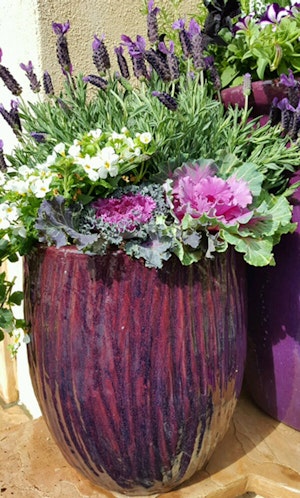 This type of container often features angular lines and traditional patterns. The weight and look of the material can make it seem like it has been in the garden for a very long time, even in new gardens. As the websites notes, “Concrete provides good insulation for soil, moderating soil temperature and moisture loss, but they are heavy. Place concrete planters where you want them and then plant.”
This type of container often features angular lines and traditional patterns. The weight and look of the material can make it seem like it has been in the garden for a very long time, even in new gardens. As the websites notes, “Concrete provides good insulation for soil, moderating soil temperature and moisture loss, but they are heavy. Place concrete planters where you want them and then plant.”
Terra-Cotta Pots
As described by HGTV, “Terra-cotta or clay pots come in many sizes, shapes and styles. Unglazed terra-cotta is porous and dries out quickly. It works well in a shady situation like this or for growing Mediterranean herbs, like lavender. Glazed terra-cotta is the go-to pot for sunny spots. Inquire about the source of terra-cotta.”
Of course, don’t feel like you need to limit yourself to concrete or terra-cotta containers. Let yourself find inspiration! For example, you could use vintage bathtubs or colorful rain boots; click here for even more fun options.
Growing Edible Plants in Containers
As we mentioned above, container gardening offers a wonderful home for edible plants. Here are a couple of popular plants that produce delightful fruit right in your chosen containers.
Avocados
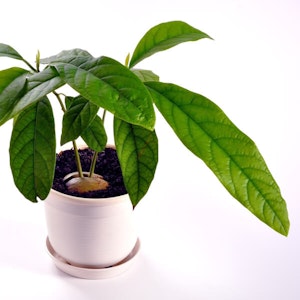 Whether you like your avocado in guacamole, in sandwiches, on toast or just with a spoon, Garden Guides offers these tips to grow avocados in our area:
Whether you like your avocado in guacamole, in sandwiches, on toast or just with a spoon, Garden Guides offers these tips to grow avocados in our area:
- Select a planting location for the avocado tree that is fast-draining and has a high nutrient value. Pick an area that is not part of a lawn and is protected from frost and wind.
- Dig a hole 2 to 3 times the width of the container the tree came in and the same depth. Loosen the soil in the hole and fill it with water. It is recommended you plant the avocado in a 15-gallon container.
- Mix equal parts of organic compost and sand with the removed soil. Gently pack the soil around the root ball.
- Build a 4-inch-high berm around the base of the plant with the remaining soil and fill it with water. The berm creates a water basin to thoroughly moisten the root ball.
- Apply a 4-inch-high layer of compost around the tree at a distance of 12 inches from the trunk.
- Give the tree a deep soaking every 2 to 4 weeks in the summer. Irrigate the tree for several hours to soak the soil and push salt away from the root ball.
- Fertilize the avocado tree with a fish emulsion 1 or 2 times during the growing season. The avocado tree does not tolerate increased salt levels and should not be fertilized with chemicals.
- Provide a sun shade June through August to prevent the tree from being burned. Plant the tree where it is shielded from the hot afternoon sun or cover the tree with a shade cloth during these months.
Strawberries
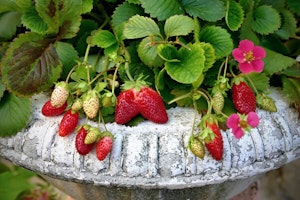 Strawberries are delicious and very easy to grow. Here is some advice from Garden Therapy to grow a strawberry patch in your containers.
Strawberries are delicious and very easy to grow. Here is some advice from Garden Therapy to grow a strawberry patch in your containers.
It is recommended strawberries be planted in loose, loamy, acidic soil with a pH between 5.3 and 6.5. Choose an area in your garden that receives 6-8 hours of sun per day. You can plant strawberries in the early spring or in the fall, and they need to be spaced at least 2 feet apart, so only plant 1 or 2 plants per container. Fill the container with a potting mix and make a small mound in the middle. Spread the roots out over the mound, cover the roots up to the crown with additional mix and water well.
When taking care of your strawberries in containers, they may require frequent watering; they need to be watered when the soil is dry to the touch – especially if the weather if hot as soil in the containers dry out faster than in the ground.
Garden Therapy also suggests overwintering, noting that, “They will produce better the following year if they are allowed to go dormant during the winter. If you live in an area that gets extremely cold, move your strawberry containers into an unheated garage or basement in the winter. Water the container only when the soil becomes dry.”
Edible Container Gardens
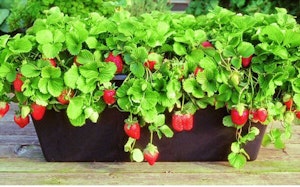
Growing plants in containers offers a unique and gorgeous look to your garden that’s even better when you can taste the fruit of your labor (literally!) and enjoy your edible flowers.
If you have any questions about container gardening or edible plants and flowers, please visit your local SummerWinds Nursery and speak to one of our Trusted Garden Advisors; we’re happy to help.

